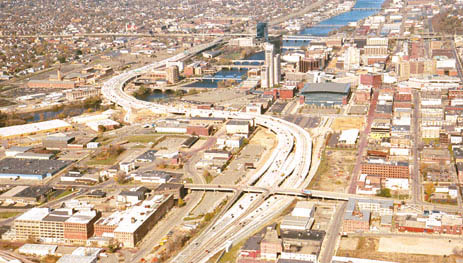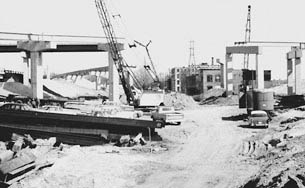City grew up around old S-Curve; new version ready for the future
Date Posted: June 8 2001
GRAND RAPIDS - The state Department of Transportation called the recently completed reconstruction of the city's notorious U.S. 131 S-Curve "by far the largest and most complex civil engineering project ever launched in West Michigan."
In 1963, constructing the original 1.2-mile, six-bridge roadway through the heart of this city was no small feat, either.
Even during a period when state and federal governments enjoyed far more flexibility in where they wanted to place public roads, building the original S-Curve didn't happen without controversy and the loss of viable buildings."Many people were as perplexed then as they are now as to the shape the freeway took," said MDOT Grand Region Office spokeswoman Julie Martin. "Many anecdotes exist in the community about how the big landowners, political power bases and leading businessmen in the community dictated which buildings could and could not be removed to build the freeway.
"When you factor that in with other obstacles, such as railroads, the river, Indian burial grounds, etc., you come up with an 'S.'"
The S-curve is a series of six bridges that carry approximately 120,000 vehicles per day over the Grand River and the city. It was never a perfect solution to the city's traffic needs: there were basically no shoulders on the six-lane road, and the entrance and exit ramps needed to be redesigned.
"Accidents weren't that disproportionate on the S-Curve compared to other sections of the freeway," said MDOT Project Engineer Suzette Peplinski, "but because there were only one-foot shoulders on the old roadway, one stalled vehicle would take a lane completely out of commission."
The S-Curve's surface was reconstructed in the 1970s, and ongoing maintenance activities have occurred as needed, but over the last few years, significant deterioration had occurred at several locations on the structures in the curve.
MDOT was evaluating renovations of the S-Curve when the subject moved to the front-burner in January 1998. It was discovered that dissolving gypsum deposits under the Grand River created a void in the bedrock, causing the support pier for the road section to drop eight inches. A temporary repair was made, but it was clear that more extensive rehabilitation was needed.
Enter contractor Kiewit Western and the building trades, who widened, strengthened, slightly straightened and completely modernized the stretch of road during a 40-week construction period that began January 9, 2000. The S-Curve was shut down, and a crew of about 280 craftspeople and 70 supervisors worked 540,000 hours to get the job done. Total cost to fix the S-Curve: $145 million.
"The people who built the S-Curve deserve a lot of credit because of the amazing sense of urgency," said Steve Nerby, project manager for Kiewit. "Working within a difficult schedule under tough conditions, everyone was committed to completing this project."
Kiewit and the building trades removed 175,000 tons of concrete from the old S-Curve, and about 7,000 tons of structural steel. They recycled about 6,000 tons of asphalt.The new bridge foundations over the Grand River were drilled to a depth of 90 feet. Four lanes were created, along with 12-foot shoulders. A system to squirt de-icing fluid over the road was installed. Entrance and exit ramps were redesigned. All under an extremely fast schedule that sought to limit the inconvenience for area motorists, who coped surprisingly well with the closure of the most heavily traveled thoroughfare in the Grand Rapids area.
With the closure of the S-Curve, there was some talk of straightening the road, but it was only talk. The city has grown up around the bends in the road. In the end, only one building was razed during the renovation process.
"The damage that would have been inflicted on the neighborhoods, schools and churches of Grand Rapids would never have been supported, or probably even allowed by law," Martin said. "And the improvements of the S-Curve solved an estimated 80 percent of the issues of the old S-Curve."

WIDER, SAFER, STRONGER and somewhat straighter than the stretch of U.S. 131 it replaced, here is the new and improved S-Curve through Grand Rapids.

IN THE EARLY 1960s, the S-Curve took on an "S" shape so the thoroughfare could go around existing buildings, and deciding which ones to raze did not come without controversy.
